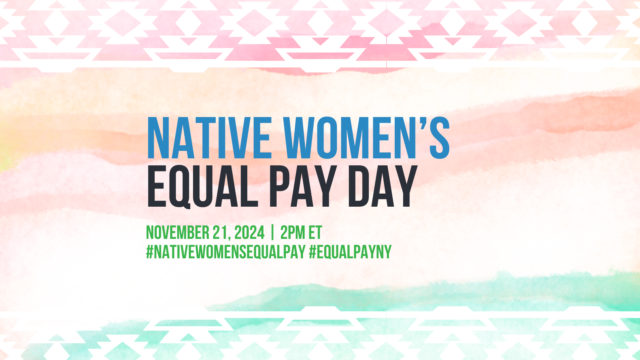Equal Pay Days signify the symbolic date when full-time working women’s wages equal the wages earned by full-time working men in the prior year. Native Women’s Equal Pay Day is the last of the year (November 21st) because Native American/Indigenous women earn the least of any group on average when compared to white, non-Hispanic men. In New York specifically, Native women earn an abysmal 54 cents to every dollar paid to white, non-Hispanic men, on average.
To raise awareness of the wage disparity and discrimination Native women continue to experience, PowHerNY led the New York Native Women’s Equal Pay Day on November 21st, 2024.
This Native Women’s Equal Pay Day, we recognized that New York has passed absolutely essential laws to advance pay equity for Native women, including the salary history ban, which prevents job applicants’ previous low wages from influencing their compensation in a new role, and the salary range disclosure law, which empowers women & all workers to be informed and negotiate for better pay.
PowHerNY also emphasized ways we need to continue the fight, like calling for our pay transparency laws to be stronger and better enforced. We need to stop employers from skirting the law with overly broad salary ranges in job postings, to require postings include other forms of compensation, and to require employers provide salary range information to current employees. New York City is leading the effort to improve pay transparency with Int 808 which would amend the NYC salary range disclosure law.
Partnering with Indigenous Justice Circle, PowHer also dove deeper into the root causes of and solutions for the persisting pay gap for Native women. Kelly K. Hallman, Founder and Executive Director of Indigenous Justice Circle outlined key issues behind economic inequity in a Native Women’s Equal Pay Day interview with PowHer New York.
The interview illuminated that Native women continue to face:
- Lack of access to financial education, credit cards, and business loans
- Caretaking responsibilities that limit their career opportunities
- Transportation barriers
- Lack of access to housing and increased domestic violence
All of which contribute to a lack of opportunity and limitations that hurt Native women’s potential to achieve economic equity. Watch the insightful interview here:
Quick facts about Native Women’s Equal Pay in New York:
- Each year, NY Native women are paid $34,059 less than white, non-Hispanic men due to the wage gap. Without this loss of income, Native women could pay for:
- 23 months of rent
- 2.4 years of child care
- Paying off student loans in 1.1 years
- Over a 40 year career, Native women in New York stand to lose $1,501,440 in wages due to the wage gap. That means NY Native women must work until age 94 to catch up to earnings a white, non-Hispanic man would make by age 60.
- Native women in New York, including both full and part time workers, only earn 46¢ to every $1 a white non-Hispanic, white male earns.
- Native women in New York working full time, year round, are paid 54¢ to every $1 a white non-Hispanic male earns.
- To achieve equal pay for Native women, we need stronger laws and substantial investment in:
- Expanding Pay Transparency Laws
- Bringing women into higher paying roles
- Fair Pay for Care workers
- Expanding Paid leave
- Making child care accessible to all
Learn more about the wage gap in New York:
The Wage Gap by State for Native Women — March 2024 | NWLC
What’s the Wage Gap in the States? | National Partnership for Women & Families
Lifetime Wage Gap Losses by State for Native Women — March 2024 | NWLC


